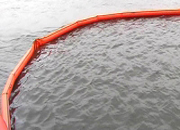Engineers trying multiple tactics in battle to plug oil well in Gulf of Mexico
Options
Engineers trying multiple tactics in battle to plug oil well in Gulf of Mexico
 "We'll be pumping pieces of tire. We'll be pumping knots in ropes," Kent Wells, senior vice president of exploration and production for BP, said in a news briefing Monday. "There's a little bit of a science in this, even though it sounds odd."
"We'll be pumping pieces of tire. We'll be pumping knots in ropes," Kent Wells, senior vice president of exploration and production for BP, said in a news briefing Monday. "There's a little bit of a science in this, even though it sounds odd."The war in the gulf since the blowout April 20 has tested the ingenuity and improvisational skills of petroleum engineers who have never tried to cap a well in mile-deep water. They're hoping for victory but hedging their bets.
"We are designing every option to be successful, and we are planning for it failing," Wells said.
The emergency response to the leak has taken on the terminology of a military campaign. There was talk Monday of multiple "fronts" in the battle (subsea, the surface, the shoreline), an "army" of engineers and experts, and an "air force" of planes spreading chemical dispersants.
Late Monday, the White House said President Obama met in the Situation Room with Cabinet members and senior staff to review BP's efforts and dispatched Energy Secretary Steven Chu to lead a team to Houston to help come up with solutions.
Although the well remained uncapped, BP executives said the chemicals, controlled fires and skimming have helped them beat back the oil slick and keep it from land. "The visible size of the spill is less significant than it was a week or 10 days ago," Doug Suttles, BP's chief operating officer, said Monday after a weekend flight over the slick.
BP chief executive Tony Hayward, asked whether the spill is imperiling his company, answered with a stiff upper lip: "It's clearly a serious situation for BP, and that is why we are so focused on resolving it. And we will. We will resolve it. It's simply a question of how long it takes."
Engineers have developed at least a half-dozen distinct lines of attack on the leaking well -- what might be called plans A through F.
Plan A was tried right away. Engineers at the surface used robotic submarines to try to close valves on a massive apparatus called the blowout preventer, which sits atop the wellhead 5,000 feet below. That tactic didn't work, and BP abandoned it.
Plan B, which received a flurry of media attention, used a 100-ton, 40-foot-tall steel containment dome, or coffer dam. On Thursday night the dome was lowered onto the largest leak, a hole in a pipe called a riser, which is now partly buried in mud.
But deep-sea chemistry foiled the effort. The dome became clogged with methane hydrates, an ice-like slush created when pressurized gas from the well mixed with cold seawater. The hydrates, which are lighter than water, stuck to the inside of the dome and made it buoyant, Suttles said.
"Washington Post"